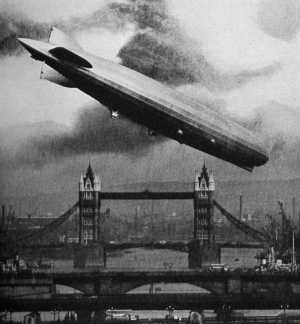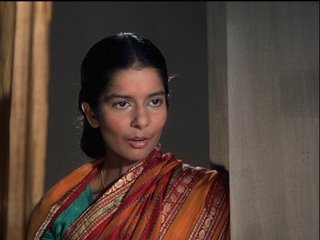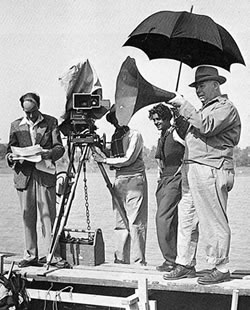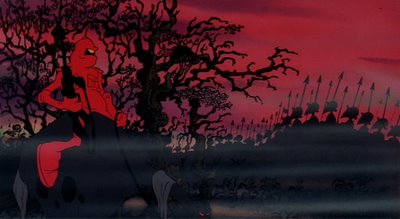April Flowers

 NR: What kind of influence has Ang Lee had on you as an editor?
NR: What kind of influence has Ang Lee had on you as an editor? TS: No, not at all. There's two types of action scenes in the film. There are fight scenes and there are chase scenes. And sometimes within a scene some sections are fights and some sections are chases. A chase scene is much less choreographed. You have a bunch of shots and there is maybe an order intended, but you can rearrange a chase scene generally. With a fight scene it's much harder. The way that these fights are choreographed, it's really very tightly planned. You can sometimes omit sections, but it’s really planned to go together a certain way. Now the problem on this film was I didn’t know what that way was. We had some communication problems with the set, them being so many time zones away and language problems. I was getting the notes very, very late, and there was not much in the way of explaining the choreography to me. Sometimes they would shoot in sequence, and sometimes they wouldn’t, and sometimes I had indications about what order the shots were supposed to go in, and more often I didn’t. So it was really kind of a jigsaw puzzle. It’s an intellectual exercise rather than an artistic exercise, in a way--just trying to figure out what the choreography was supposed to be, especially when sometimes some of the pieces were missing.
TS: No, not at all. There's two types of action scenes in the film. There are fight scenes and there are chase scenes. And sometimes within a scene some sections are fights and some sections are chases. A chase scene is much less choreographed. You have a bunch of shots and there is maybe an order intended, but you can rearrange a chase scene generally. With a fight scene it's much harder. The way that these fights are choreographed, it's really very tightly planned. You can sometimes omit sections, but it’s really planned to go together a certain way. Now the problem on this film was I didn’t know what that way was. We had some communication problems with the set, them being so many time zones away and language problems. I was getting the notes very, very late, and there was not much in the way of explaining the choreography to me. Sometimes they would shoot in sequence, and sometimes they wouldn’t, and sometimes I had indications about what order the shots were supposed to go in, and more often I didn’t. So it was really kind of a jigsaw puzzle. It’s an intellectual exercise rather than an artistic exercise, in a way--just trying to figure out what the choreography was supposed to be, especially when sometimes some of the pieces were missing.
September. 1st, 1984
The first real entry in a journal I’ve been meaning to start for at least the past several years.
It is near midnight and I am quite tired, having gotten little sleep last night and the monotonous 4-hour trip to my grandmother’s here in Mogadore, Ohio, a suburb of Akron.
My grandfather is not well having had a stroke 2 years ago his health has steadily declined. Today I saw him again for the first time in a month and a half.
I approached the home he is staying in with another man and two women with considerable dread.
I don’t think I quite have the hang of this journal thing yet.
But I tried to steady myself against my fear by viewing it as a completely unique experience that, as a writer, I should embrace. All kinds of mad fears flooded my thoughts as we (my father, Aunt Eileen, and I) ascended the stairs to his room. What if he has just now died? What if he dies in our presence? These thoughts disgust me now, but nevertheless these were my feelings at the time.
We passed through the room adjacent to my grandfather Marvin’s to see an old man in a white hospital smock sitting asleep, his head lolling to one side.
When I saw the horribly thin frail creature sitting in a chair staring at the television I was shocked. It was very much like seeing a completely different person and it took me some time for me to fully feel that this was Grandfather. He has lost conservatively 20lbs (current weight 135lbs??) because he eats next to nothing. Whether he is unable or unwilling or simply uncomprehending, I don’t know. His false teeth and his glasses do not fit him because of his weight loss.
When asked by Aunt Eileen what he would like he replied, “Ice cream”. Ice cream is one of the few things he really seems to want and enjoy.
When he spoke today it was in a barely audible whisper. It was very difficult to get his attention or to keep it for very long when speaking. Dad tried to make him promise to eat something for him and it was a considerable time before he recieved any acknowledgement at all.
Grandma who had come in the same car with Dad and I did not come upstairs until after Aunt Eileen and we had spent some time with Grandfather.
As Grandma entered the room she cried and I think Grandpa might have cried a bit as well. The two of them, at that moment (as Grandma had his hand in hers) reminded me of two battered weary adventurers just trying to ride the storm out to its end.
 One of the great blogging conundrums - or conundra (yes, I'm still sticking with the serif font - for now) (just you wait, when my new font strikes, people will freak right out) (right out) (I promise) - is the wondering if one has any kind of life worth telling. Could my life be of interest? Why in the world would anyone want to read about me? Why? Why the hell?
One of the great blogging conundrums - or conundra (yes, I'm still sticking with the serif font - for now) (just you wait, when my new font strikes, people will freak right out) (right out) (I promise) - is the wondering if one has any kind of life worth telling. Could my life be of interest? Why in the world would anyone want to read about me? Why? Why the hell?

Featuring:
- What is a dirigible?
- Adrenaline at 35,000 feet
- Smoking is cool ...
- ... and fatal
Episode 2 of the Imagination →
Labels: podcasts
 I have heard Queen Elizabeth II speak. Or give speeches, at least - which is very similar to speaking. I even have seen the Royal Her in the flesh once or twice. She came down to the University of Kent at Canterbury when I was there, with her hubby in tow, and some of the rest of The Family (like that guy with the ears, who was married to that girl who died - he came) to open the university's new vertebrate vivisection wing.
I have heard Queen Elizabeth II speak. Or give speeches, at least - which is very similar to speaking. I even have seen the Royal Her in the flesh once or twice. She came down to the University of Kent at Canterbury when I was there, with her hubby in tow, and some of the rest of The Family (like that guy with the ears, who was married to that girl who died - he came) to open the university's new vertebrate vivisection wing.10 Words The Queen Has NEVER Used
- Femidom
- Goyim
- Klingon
- Pentium
- Lobot
- Nucular
- Pizzazz
- Shit-hole
- Spliff
- Triceratops
Labels: Top 10 Lists
 My 1st viewing of "The River" was in London, on New Year's Day, 2005, on my honeymoon. My wife and I went to the screening of a newly restored version of the film that the National Film Theatre was introducing as part of its "India Vu Par" series. I count it as one of the fine filmgoing experiences of my life - taking my new wife to that cinema Mecca beside The Thames, where I had sat alone on my visits to the UK, in the 90's and in the 80's, watching "Dr. Zhivago", watching "The Pillow Book", watching "The Last House On The Left" (or was it "The Hills Have Eyes"?), browsing before and after the tables of used books out front, or sitting by the river writing an over-romantic letter to whoever I was dating, waiting for the screening to start, or gushing to the poor girl all about a film I just saw that she couldn't care less about.
My 1st viewing of "The River" was in London, on New Year's Day, 2005, on my honeymoon. My wife and I went to the screening of a newly restored version of the film that the National Film Theatre was introducing as part of its "India Vu Par" series. I count it as one of the fine filmgoing experiences of my life - taking my new wife to that cinema Mecca beside The Thames, where I had sat alone on my visits to the UK, in the 90's and in the 80's, watching "Dr. Zhivago", watching "The Pillow Book", watching "The Last House On The Left" (or was it "The Hills Have Eyes"?), browsing before and after the tables of used books out front, or sitting by the river writing an over-romantic letter to whoever I was dating, waiting for the screening to start, or gushing to the poor girl all about a film I just saw that she couldn't care less about. But what I really want is to see a digital restoration of "The River" - like the recent "Singin' in the Rain" restoration. The Academy is dedicated soley to photographic restoration of films, which is a key component of preservation of the actual film materials and is vital in keeping the films around for the long, long term, and so a great digital restoration is outside their mandate. And "The River" money has been spent. That's it. No more restorations of "The River". It's had it's turn. I am told the DVD transfer of the film is very, very good however.
But what I really want is to see a digital restoration of "The River" - like the recent "Singin' in the Rain" restoration. The Academy is dedicated soley to photographic restoration of films, which is a key component of preservation of the actual film materials and is vital in keeping the films around for the long, long term, and so a great digital restoration is outside their mandate. And "The River" money has been spent. That's it. No more restorations of "The River". It's had it's turn. I am told the DVD transfer of the film is very, very good however.Labels: movies
NEAL: Hello, Carolyn, Tony, and Rob! Before we begin, shall I refer to you three in alphabetical order according to first name or last name?
CAROLYN: Like we give a shit.
TONY: Is this the weirdo you were talking about?
ROB: Yeah, that's him. I'm surprised he showed up. He's always flaking.
TONY: I hate people who flake. I hate this guy already.
ROB: You think you hate him now. You don't know him.
CAROLYN: I hear he killed a man.
ROB: You don't know the half of it.
CAROLYN: I don't want to know.
ROB: Did you know that he used to write a check to pay for a bus ticket?
TONY: That's impossible.
ROB: No. It can be done. He proved it could be done. That is his one and only contribution to society - proving you can write a check to pay for the bus. Provided you are in a Third World country - like England.
NEAL: Mind if I sit down?
CAROLYN, ROB and TONY look at each other.
NEAL sits before they can say anything.
NEAL: Hey, Carolyn. Listened to your interview with Jonathan Ames. Nice work.
CAROLYN: Please don't tell me that. It makes me feel dirty.
NEAL: Oh, and hi, Tony. I'm very pleased to meet you. Rob told me about your blog long ago, after he told me I needed to start a blog. He said: 'You should start your own blog. But check out Tony Pierce's busblog first, because if you just start writing whatever's in your head, a lot of people are going to throw up'. Rob is wise.
CAROLYN: (throws up)
NEAL: Oh, and, shit, on the way over here, I listened to the end of that game. And shit! Ninth inning - SMACK! GO BIG BLOOOOOOOOOOOOOO!!!!!!!!!!!
TONY leaps to his feet, smashes a glass into NEAL's face.
NEAL: Oh, my eyes!! My precious eyes!!
NEAL falls to the ground. CAROLYN starts kicking.
NEAL: Oh, my groin!! My precious, precious groin!!
ROB: You and your groin! Always, always you and your goddamn groin!
CAROLYN: Let's go get that hot dog.
CAROLYN, ROB, and TONY exit, leaving NEAL writhing on the carpet.
After a moment, TONY returns, grabbing the pot of freshly brewed coffee from behind the bar. He pours it on NEAL's head.
NEAL: Aaagh. My scalp! My semi-precious scalp! O, coffee! Et tu, coffee?! Et tu?!
TONY: And that's for those Obnoxious Jesus Cartoons of yours!
TONY exits. The WAITERS call 911 in an hour or two.
 It's possible that I never showed up to Musso and Frank's because of a private situation that required my attention. That is possible.
It's possible that I never showed up to Musso and Frank's because of a private situation that required my attention. That is possible.
DYING HOLLYWOOD
- Blockbuster stores
- Development, production, and distribution times relatively long
- Creation by committee
- Corporate control
- $1 million
- Creators/Producers have little or no contact with their intended audience
- Economy of scale
- Buying & selling
- Rewards determined by negotiation
- Mohammed must come to the mountain
THE NEW MOTION PICTURE
- Netflix
- Development, production, and distribution times infinitely flexible
- Creation by author(s)
- Corporate assistance
- $100,000
- Author communicates directly with audiences
- Economy of need
- Sharing & trading
- Rewards determined by merit
- The mountain must come to Mohammed
The First 10 Verbs of "Fortune and the Devil"
- raise
- rotate
- sharpen
- wind
- fit
- draw
- polish
- slide
- slide
- exits

| You Should Be a Science Fiction Writer |
 Your ideas are very strange, and people often wonder what planet you're from. And while you may have some problems being "normal," you'll have no problems writing sci-fi. Whether it's epic films, important novels, or vivid comics... Your own little universe could leave an important mark on the world! |
Dear Young Screenwriter,
I've jotted down some things for you to consider. I have had some experience in the grand attempt to become a writer of movies. I have done it badly. But that's okay. Everyone does it badly. No one anywhere does anything as well as they think they should have. Those rare few that do are either enlightened or, more likely, imbeciles.
I urge you to study the following suggestions, which I have written down in no particular order - even though I have numbered them.20 Suggestions To A Young Screenwriter
- Read. Read screenplays. Read them in screenplay format, printed on single sides of 8 1/2 x 11 paper. Hold a screenplay in your hands, with brass fasteners in it, with a cover page, as often as you can. Don't be afraid of killing trees. If you're that worried about the environment, then sell your car.
- Help other writers - nothing cures the strangling self-obsession and despair of the writing game like trying to help another writer make his/her story the best it can be. As a wise old man once said, probably quoting another wise old man, "There is no end to what you can accomplish, if you don't care who gets the credit."
- Watch movies - lots of movies. Watch the movies you like again and again and again. Become an expert on your favorite movies.
- Find a hero and become an expert on that hero's life. If you don't know who your favorite screenwriter is, pick one.
- Find a secondary art that you love, other than screenwriting, and practice it whenever the hell you feel like it. I like photography and drawing. Other people enjoy disco dancing.
- Don't be afraid of other people's feedback. On the other hand, trust yourself utterly - 8 times out of 10 you are right about that idea.
- But on the other other hand, things often go better when you assume you know nothing. Just bear in mind that when William Goldman says "No one knows anything", he means you too.
- Write the movie that you think is the coolest movie ever - trust your own taste. Eventually, you may find out that you are a lousy sci-fi writer and brilliant at comedy. Or find out that you are a lousy screenwriter but a brilliant novelist. But you will never find this out if you keep writing what you think other people want.
- Love your characters - desire them, whisper to them, sneak into their bodies and walk around in them, treat them as if you were a jealous ghost obsessed with their every waking and sleeping moment
- Love your audience - enjoy imagining the pleasure they will get from reading your script/seeing your movie, treat them as if you were a secret admirer whose only wish is that you could see the look on their face when they read that one scene. You know the scene I mean.
- Write as many scripts as you can. Accumulate a varied library of your own screenwriting. One finished mediocre script is worth more than an unfinished script which will be really great when it's finished.
- Write as many days a week as you can.
- A surprising amount of writing can be done in 10 minutes. If 10 minutes is all you have, take it.
- Rewriting is only valuable, when know what to leave alone. It is dangerously easy to suck all the blood and breath out of a script with unjudicious rewriting.
- Tell your agent to fuck off once in a while.
- Never accept the water. If you meet with a potential fan and they offer you a water - or a coffee - while you are waiting, refuse it. Do not let them off the hook. You are not there for refreshment, you are there for work (Obviously, this does not apply if it is a lunch or dinner meeting. Refusing the water in that case makes you look like a maniac).
- Avoid looking like a maniac. Don't be afraid that you won't stand out as someone interesting and unique. People who are afraid that they won't stand out, usually try to do things to make themselves stand out. These people make others very nervous and are usually shunned and ignored. You want to be friends with as many people as possible. Make it easy for them.
- If you can't remember what you did the night before more than once a week, deal with that problem first and put the writing career on hold. You're wasting valuable time trying to serve two masters.
- If you want to be in the movie business in order to become rich and famous and powerful, or to get revenge on your enemies, or to make your parents proud, or to fill that horrifying emptiness in your chest, please TRY SOMETHING ELSE. If you are meant to be in the movie business, you will be lead back to it.
- Finally, please throw this list of suggestions away. Do it immediately.
Always yours,
- Neal

"And here on my left is Dave Taylor who is, as you can see quite plainly, a gigantic lizard. And beside him is Sean O'Keefe just back from another harrowing voyage in the North Sea - all hail Lord Osiris, may his name live forever! Yeow! The guns! Jesus God! The GUNS!!!"


"No. That's not true. That's impossible!"And so then Gary Gygax said to me:
"Search your feelings, Neal. You know it to be true."And then I squealed like a little piggy:
"Noooo! Noooo! ..."And then coming to my senses:
"... Oh, no. Wait. Yes! Yes! Of course! That explains a lot."Yes, Gary Gygax is my father.
 "Star Wars" (1977) - not "Star Wars, Episode IV: A New Hope" (various years) - got a lot of us going, but if if I'm brutally honest, the greatest formative influence on my creative life - apart from Mad magazine - was probably Gary Gygax and his Advanced Dungeons & Dragons.
"Star Wars" (1977) - not "Star Wars, Episode IV: A New Hope" (various years) - got a lot of us going, but if if I'm brutally honest, the greatest formative influence on my creative life - apart from Mad magazine - was probably Gary Gygax and his Advanced Dungeons & Dragons. Within a week of that first game, my father, tragically ignorant of what he was unleashing, bought me the "Advanced Dungeons & Dragons Players Handbook". "The Monster Manual", "The Dungeon Master's Guide" quickly followed. And I was the first kid on my block to get "Deities & Demigods" and "The Fiend Folio". I was off and running, and became a Dungeon Master myself (becoming a Dungeon Master is exactly like being a producer in Hollywood - you just tell everyone you are one, then invite your friends to play your game). I engineered epic campaigns with casts of thousands, with elaborate improved rules that I'd invented, with stories of great subtlety and emotional depth and even my supporting characters (derogatorially referred to by some as "non-player characters") had elaborate and, often moving, backstories.
Within a week of that first game, my father, tragically ignorant of what he was unleashing, bought me the "Advanced Dungeons & Dragons Players Handbook". "The Monster Manual", "The Dungeon Master's Guide" quickly followed. And I was the first kid on my block to get "Deities & Demigods" and "The Fiend Folio". I was off and running, and became a Dungeon Master myself (becoming a Dungeon Master is exactly like being a producer in Hollywood - you just tell everyone you are one, then invite your friends to play your game). I engineered epic campaigns with casts of thousands, with elaborate improved rules that I'd invented, with stories of great subtlety and emotional depth and even my supporting characters (derogatorially referred to by some as "non-player characters") had elaborate and, often moving, backstories.